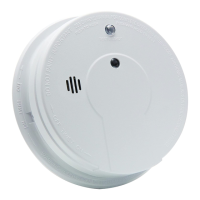8. GOOD SAFETY HABITS
DEVELOP AND PRACTICE A PLAN OF ESCAPE
• Install and maintain fire extinguishers on every level of the home
and in the kitchen, basement and garage. Know how to use a
fire extinguisher prior to an emergency.
• Make a floor plan indicating all doors and windows and at least
two (2) escape routes from each room. Second story windows
may need a rope or chain ladder.
• Have a family meeting and discuss your escape plan, showing
everyone what to do in case of fire.
• Determine a place outside your home where you all can meet
if a fire occurs.
• Familiarize everyone with the sound of the smoke alarm and
train them to leave your home when they hear it.
• Practice a fire drill at least every six months, including fire drills
at night. Ensure that small children hear the alarm and wake
when it sounds. They must wake up in order to execute the
escape plan. Practice allows all occupants to test your plan
before an emergency. You may not be able to reach your chil-
dren. It is important they know what to do.
• Current studies have shown smoke alarms may not awaken all
sleeping individuals, and that it is the responsibility of individuals
in the household that are capable of assisting others to provide
assistance to those who may not be awakened by the alarm
sound, or to those who may be incapable of safely evacuating
the area unassisted.
WHAT TO DO WHEN THE ALARM SOUNDS
• Alert small children in the home.
• Leave immediately by your escape plan. Every second counts,
so don’t waste time getting dressed or picking up valuables.
• In leaving, don’t open any inside door without first feeling its
surface. If hot, or if you see smoke seeping through cracks,
don’t open that door! Instead, use your alternate exit. If the
inside of the door is cool, place your shoulder against it, open it
slightly and be ready to slam it shut if heat and smoke rush in.
1375-7213-00(21008164-EN A).indd 131375-7213-00(21008164-EN A).indd 13 2010.10.7 2:06:25 PM2010.10.7 2:06:25 PM

